
|   |

|   |
 e-mail: sunilkothari1933@gmail.com 14th Edition of the Music Academy Dance Festival The marathon sessions Photos courtesy: The Music Academy January 27, 2020 Hot on the heels of the 39th Natya Kala Conference came the 14th edition of The Music Academy's dance festival from 3rd till 9th January 2020 at their spacious and well equipped auditorium with light and sound system. This year's festival had added features: one more slot at 2pm for dancers. There were three interactive sessions with three dancers on three days from 4pm till 5.30pm at one of the committee rooms, where participants were served coffee on the house. Prior registration was arranged and slips were required to be dropped in a box. Those whose slips were selected could attend the session for dialogue with the dancers. There were panel discussions on three mornings from 8.30am till 10am, followed by 10am and 11. 30am slots for dance. After lunch, the new 2pm slot made it quite taxing and also exhausting! Whatever may be the reason that Academy has planned this additional slot, whereby 6 more dancers could be accommodated, they will have to rethink the timing in order for public to attend the post lunch performance. The evening sessions from 6pm to 7.30pm and 7.45pm till 9.15pm were ticketed as usual whereas all other sessions are free for the public. This festival has acquired reputation for featuring the best of the classical dancers. Therefore die-hard followers plan to attend well in advance. Some of us ventured to attend all sessions. No wonder, when I am trying to review the performances which I saw during the seven days, I am dead exhausted and my mind is full of overlapping images of endless varnams, padams, tillanas and what have you. The saturation point naturally starts working upon onlookers. Alarmel Valli 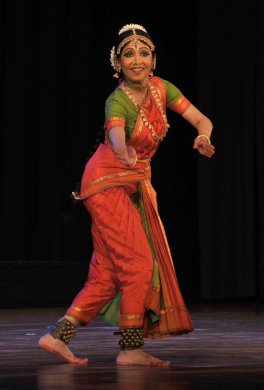 On 4th January, Alarmel Valli presented her solo Bharatanatyam performance. This was a special year as she returns to the Music Academy stage after a bout of illness. She looked her usual self, full of beans and enthusiasm. The audience welcomed her with affection. Valli's introductions are a sheer delight to listen to. The references to poetry, the classic like Kalidasa's Ritusamhara, Meghaduta, the boundless beauty of nature which permeates the world and is shared by the birds, animals, trees, human beings, find a felicitous expression in her dance. Titling the performance as 'Scent of the Earth,' the invocation Jeevanam Jeevamritham, a composition of N. Arumugam in Ragamalika and adi tala to the music composed by her long time associate Prema Ramamoorthy, she recreated the raindrops, the fragrance of the earth which envelopes one and all, the dancing peacock looking up at the clouds, the lightning, rising waves of water, and from heaven watch the Gandharvas and Apsaras, and then prevails peace. Having set the tone, Valli presented padavarnam Kaana Avalanen in Ragamalika, tala rupakam, to music composed by Prema Ramamoorthy. It echoed the voice of a woman longing for the beloved, a devotee wanting to have a glimpse of Lord Shiva, with such intensity and yearning. Crossing the pavilions of the temple, she enters the Golden Hall, Tillai, where the magnificent form of her beloved is seen that dazzles her eyes in wonder. The sculptures, the patterns on pillars, their heights, overwhelm her. The offering of the arati with lamp, the dancers dancing, she takes the aska and puts it on her head. She notices the cooing of birds and tells them to stop their prattle, as it is the moment for meditating. She looks at the crescent moon on the lord's head. In gatherings of the clouds, she sees the image of her lord. His riding over Nandi, the simile of the bee and the lotus, suggestive pairs of birds and deer, all indicate her desire to be one with the lord. Valli selected Pushpa Vilapam, a Telugu poem by Karunasri Jandhyala Papayya Sastry, translated into English by J Satyananda Kumar. The unusual theme dwells upon the violence human beings unleash on nature. When plucking flowers for her morning prayers, she listens to their cry, separating them from the stem, taking them to make a garland, piercing needle that tears their bodies; they are tied up by thread, offered to the lord, and later on discarded. They are crushed and grounded to make scent. The flowers are separated as children from parents. The cry of the flowers finds expression in Valli's undulating movements which suggest intense agony and pain. Valli concluded her performance with Nrityalahari, the joyous waves, a special dance number to the music composition of Prema Ramamoorthy. It was a pleasure to see her in form once again. The musical accompaniment was vocal by Nandini Sharma Anand, nattuvangam by C K Vasudevan, percussion by Sakthivel Muruganantham, violin by K P Nandini and flute by J B Sruti Sagar. The lighting was by Murugan. Thyagaraja Vaibhavam by VP Dhananjayan's group Natyacharya VP Dhananjayan and his troupe presented Thyagaraja Vaibhavam. Through the episodes from the life of Thyagaraja, the dance drama brought out the best of his compositions. Thyagaraja Vaibhavam was a fitting tribute to a musical genius. I unfortunately could not attend the full performance. Rama Vaidyanathan 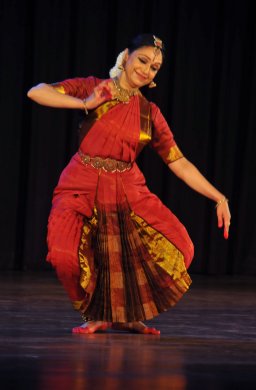 On 5th January, Rama Vaidyanathan presented a Margam completely based on Lord Muruga. Skanda Murtay depicted the mystical circumstance under which Lord Muruga was born. The research undertaken was quite illuminating which enhanced the dramatic narrative set to lyrics of Adi Shankara with music composition by Sudha Raghuraman. It was interesting to watch the several meanings of the word Skanda employed by Rama. Siva's innate energy in the form of fire that spilled in the forest, six lotuses that emerged, the Kritikas who nurtured, Parvati who gathered them into one, and finally the emergence of the warrior prince Murugan. Muruga is the ultimate savior, the killer of demons, husband of Valli and Devayani and darling son of Siva and Parvati. The images in dance wove a tapestry of Skanda's story of birth. The varnam Swamiye azhaithodi vaa, a composition of Dandayudhapani Pillai, set to Purvikalyani raga and adi tala with jathis by Ramamoorthy Sriganesh was a tour de force. The nayika tells her sakhi to bring Lord Kumara to her. The sancharis Rama employed were arresting for depicting the various ways in which she tells her confidante he can come to her. For instance, 'stealthily holding my hand or he can surprise me by embracing me while I am asleep.' 'O friend, go and tell him that being away from him, tears my heart.' The frustration she feels was palpable. The way Manmatha's arrows with flowers were thrown, was imbued with delicacy. The utplavanas, the jumping, playfully moving, as if borne in air, the images of Manmatha were etched beautifully. The nayika beseeches her sakhi to go and tell the lord she is suffering the pangs of separation. The nritta with variegated patterns, and the perfect execution of teermanams showed her command over pure dance and abhinaya. Rama followed with a Tamil padam Edungaanum inda in raga Kambodhi and misra chapu tala, given to her by Bragha Bessell. The nayika is extremely annoyed with Murgan for he goes around recounting his amorous secrets with her to all her friends. She is upset and has not taken this information kindly. She says: 'You come looking like a pious man. I cannot even tell this is the man who is capable of killing Soorapadman. You kiss and tell, thereby breaking my trust. Do you at all realize that you have turned all my friends against me? This will not work any longer, please go away!' The feelings of hurt, surprise at her beloved's behaviour, sarcasm, speaking directly without mincing words and looking at him with eyes more eloquent than the words, Rama as offended nayika conveyed clearly that she was in no mood to forgive the beloved. Sudha Raghuraman composed Tillana in Ragamalika and adi tala incorporating Kanda Sashti Kavacham. It was an apt ending for the thematic presentation. The musical accompaniment was given by Dr S. Vasudevan (nattuvangam), Sudha Raghuraman (vocal), Sumodh Sreedharan (mridangam) and G. Raghuraman (flute). 'Alapadma -the Lotus Unfolds' by Apsaras Arts Dance Company 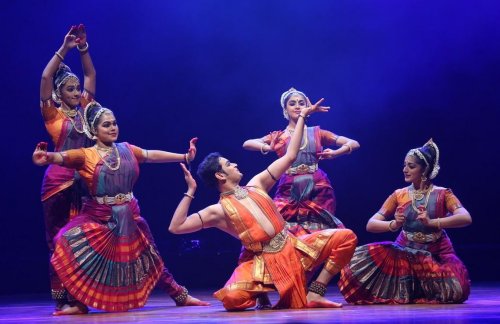 Apsaras Arts Dance Company from Singapore was founded in 1977 by alumni of Kalakshetra, S. Sathyalingam and Neila Sathyalingam. It has gained recognition in Indian dance-theatre. Exploring the multiple symbolic representations of lotus in the different cultures of the world, the production weaves in mythology, iconography, and philosophy in particular of the ancient civilization of India. Alapadma is the hasta mudra representing fully blown lotus and is found in the Natyashastra and Abhinaya Darpana texts. The many aspects of lotus such as Srishti Sarasija signifying creation, Pada Pankaja as in mythology, Leela Kamala as in romance, Alankara Ambuja as in iconography and Sahasrara Padmam as human wisdom, were woven imaginatively using the Bharatanatyam technique by the well trained dancers of the company. The production reflected both abstract and physical universe, covering the spiritual realm. Lotus offered enough scope to the choreographer Mohanapriyan Thavarajah, the principal performer who also designed the costumes. The concept and artistic direction were by Aravinth Kumarasamy. The opening scene, a tableau like sequence showed Seshasayi Vishnu with the lotus stem springing from his navel and in the lotus was seated four faced Brahma. Lakshmi pressing the legs of the lord and above Vishnu's head the multi hooded Sesha acted as a royal umbrella. The image was striking and as it developed further, the four dancers moved in circle close to each other suggesting the four faces of Brahma. The viniyogas as mentioned in Abhinaya Darpana of Alapadma hasta were imaginatively employed, not only by showing the positions and how the hasta is formatted with fingers, but also in consonance with body postures. The suggestion of Chandrashala gave scope to the choreographer to create a situation of love play between the nayaka and nayaki on the terrace with moon shining in the sky. In Dhammila, the hair bun was shown, the way the hasta was held at the back of the head, and face lifted up, creating exquisite visual. In some sequences even the separation was shown that Alapadma hasta conveyed in a narrative. Divided into 5 scenes, the choreographer has covered lotus not only as a creation, but also as a metaphor for human wisdom providing scope for imaginative choreography. From Tulasidasa's Rama Charita Manas, where Rama's face, hands, feet, entire body are compared with beauty of lotus, Kamba Ramayana's poetic references to lotus as lamps when peacocks dance to tunes of humming bees, in Leela Kamala, the story of birth of Shanmukha with six lotus faces, and finally Sahasrara, thousand petal lotus from base of spine to the crown of head as symbol of human wisdom, one watched the 'unfolding of the lotus'. Music composition was by Aravinth Kumarasamy, Dr Rajkumar Bharathi and Chithrapoornima Sathish. The vocalist Chithrapoornima Sathish, with her melodious voice lifted the production to an enjoyable level. Karthik Raveendran's support was admirable. The accompanists consisted of local artistes like nattuvangam by Sheejith Krishna, mridangam by V. Vedakrishnan, violin by Easwar Ramakrishnan, flute by Sruthi Sagar, percussions by Ganapathi Venkatasubramaniam and veena by Kasthuri Sahadevan. Malavika Sarukkai 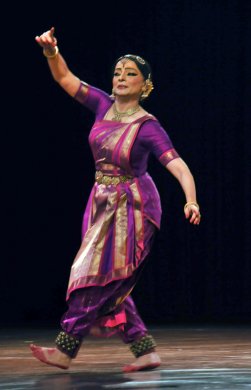 On the 6th January when the curtain rose, Malavika Sarukkai appeared on the stage looking in great form. She has completed fifty years of performances and is continuously exploring the Bharatanatyam form wanting to achieve much more than what she already has so far. Opening with Thyagaraja's Shambho Mahadev in Pantuvarali and rupaka talam, she verily created before our eyes the great Himalayas, nature in abundance, the world of animals and birds. In Bhagiratha's penance, requesting Mahadeva to receive Ganga in his Jata, Malavika created waves all over the space. He is Gangadhara, holding Ganga in his locks. The images began to take shape with Malavika's special gift for parallel images she sees in miniature paintings. The Varnam Sumasayaka in Karnataka Kapi and rupaka talam, a composition of Swati Thirunal, found unusual treatment in Malavika's rendering. Describing the Lord reclining on the coils of Shesh naga on the milky ocean, and juxtaposing the state in which a nayika is pining for her lord, Malavika created contrasts artistically. For her time is present when she pines for the lord, and the lord is the creator of time, the cosmic cycle; the Sakhi speaks of Manmatha and his showering of flowery arrows. Malavika's nritta is sparkling. She slices the air with her arms horizontally and the impact is arresting. It has become a signature of Malavika's nritta. The geometric patterns and unusual movements look anew the way she performs. Sakhi says that in separation the nayika is preparing the bed with rose petals. Malavika performed in slow motion to suggest the time, 'samaya', emphasizing what time means to the god, the nayika with utkantha, feeling disappointed at his delay in arriving. 'You are sarasijanabha, from whose navel a stem springs with lotus on which is seated Brahma; the lotus for you is a decoration, but for her lotus provides relief. Your indifference hurts her. She is exhausted and walks slowly, whereas Kamadeva walks with arrogance.' In nritta section Malavika displays beauty of the form. Raising foot horizontally like Dandapada, she revels in tala and pure dance movements. From her earlier creations Malavika presented the queen's anxiety in 'Aaparcchanam' sequence with lyrics by S.V. Seshadri and music by Meera Seshadri, when the queen's son leaves for war. Inspired from the sculptures and arrays of war scenes at Khajuraho, Malavika portrayed the anxiety of the mother, also aware of the duty of a king's son to go to war, the uncertainty of war, and having inner prayers for his safety. It was poignant and moving. Concluding her performance Malavika presented Laya in Durga and talas adi and rupakam to music composed by C.V. Chandrashekar. For Malavika, dance is a journey from outer distractions as a devotee watching the outer decorations, sculptures on temple, finds inner peace when he enters the sanctum sanctorum. In Laya, Malavika created that inner peace. Neela Sukanya (nattuvangam), Vasudha Ravi (vocal), Nellai A Balaji (mridangam) and Srilakshmi Venkatramani (violin) gave her able accompaniment. Costume design was by Sandhya Raman, and lights by Murgan. Gauri Diwakar 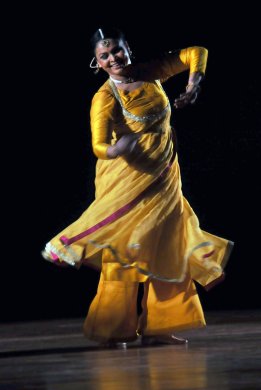 From Delhi, Kathak exponent Gauri Diwakar presented her solo Kathak performance with the accompaniment of vocal and harmonium by Samiullah Khan, on tabla Yogesh Gangani, on pakhawaj Aashish Gangani and on flute Ravindra Rajput. Dressed in an exquisite yellow costume, Gauri, in the very first item 'Resonance' in Kaafi raga and teentaal to the melodious singing by Samiullah Khan, created an impact of a dance form which has won critical acclaim and popularity universally. Weaving the intra forms of Kathak like tode, tukde, paran, gat nikas, tatkar, footwork, and enacting abhinaya to songs selected from poets Maulana Sayyad Fazul Hasan 'Hasrat', Malik Mohammad Jayasi, Mian Wahid Ali, Sayyad Mubarak Ali Bilgrami, Gauri presented the essence of unity and oneness with god. Dancing diagonally entering from the wing, performing pure dance, she created a favourable impression. Through her choice of poems, the inherent philosophy was communicative. In 'Shadow of each other,' the images of Krishna and Radha were explored with imaginative lighting by Govind Singh Yadav, casting two shadows on the back curtain .The poetic metaphor of two different bodies was illumined both in nritta and abhinaya. Gauri wove in well known aamad, 'dha taka dhunga' and parans in a seamless manner. Sitting on the floor, and reciting mnemonic syllables of Kathak, she displayed virtuosity and command over tala and laya. The spins, the hall mark of Kathak, were employed artistically. In item titled 'One' to Shudha Sarang raga in teentaal, Gauri used what is known as 'Kavit' in Kathak, describing the beauty of Krishna, his magical flute, heart winning smile, 'muskan', the gait like 'Khanjan' bird and dancing eyes, reciting first in a seated position. She then danced various gaits which had seductive touches and also the khubsoorati, beauty and nazakat, delicacy of Lucknow gharana. In Kathak the percussionist and the dancer engage in a repartee challenging each other like one poses the problem and the other replies with matching execution of footwork to the bols on tabla. Yogesh Gangani and Gauri did a fine job of it. One more noteworthy feature was the footwork and the dancer displays her command over the ankle bells. From a resounding tatkar to extremely gentle tintinnabulation of one ankle bell, Gauri performed it confidently. The inclusion of tarana as a part of the item lent texture to the number. Finally concluding her performance with 'Hari ho gati meri' Gauri won over the audience with her sophisticated Kathak. This is a new face of Kathak that has been engaging the young exponents. Narthaki Nataraj 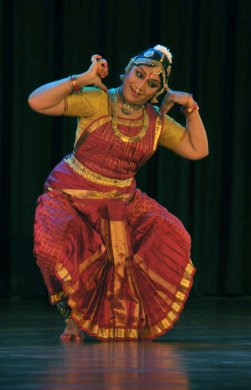 On 7th January, Narthaki Nataraj, disciple of Guru Kittappa Pillai, presented her solo Bharatanatyam recital. She has explored Tamil literature both ancient and modern and has introduced rare works of poetry and folklore in her repertoire. Narthaki's appearance during 39th Natya Kala Conference in the morning session of Legacy of her guru Kitappa Pillai had raised great expectations for her recital for The Music Academy Dance Festival. She is a versatile dancer, with bhavas at her beck and call. In the opening item with shlokam and stuti in praise of goddess Meenakshi of Madurai, a composition of Shyama Sastri, set to Sankarabharanam raga and adi tala, the goddess is described as Meenanetri, eyes like fish, and further developing the character with the story of the goddess born out of Yagna, with three breasts, trained as a warrior, expert in warfare, shooting arrows and wielding swords et al were well enacted by Narthaki. The similes of comparing long stresses with rainy clouds, her face more bright than full moon, were arresting. The poetic images were enjoyable. The Tanjore Quartet varnam by Sivanandam, Mohalahiri in Todi raga and adi tala was performed with finesse. Set in praise of Rajagopala, the nayika's yearning to be one with the Lord of Mannargudi, saw Narthaki elaborating upon the image of Manmatha. What a glorious image she created! Manmatha comes with a royal umbrella of moon, the flag carries the symbol of a fish, his chariot is wind, and he rides over parrots, his vehicle. He comes surrounded by beautiful maidens, with music of the birds, and waves of sounds of the drums. He holds sugarcane bow, stringed by honey bees, and carries arrows with flowers. He strikes the nayika which enhances her agony of separation from the lord. In one of the sancharis, Narthaki enacted the event when Radha and Krishna exchanged their robes, to suggest there are two bodies but one soul, union of jeevatma and paramatma. The way Narthaki suggestively enacted taking off her clothes and looking back from her bower at Krishna, seeing Krishna looking at her, she is embarrassed and hides herself! The feeling of lajja, shyness was beautifully portrayed. In Braj bhasha there is a song where Gopis tell Krishna, 'Let us dress you up as Radha and Radha as Krishna' - Aaj tumhe ham nari banaye. The poetic image is to suggest their unity. Narthaki invested the varnam with poetic images. The padam Yennakkum Unakkum in Abheri and Tisra Nadai, a composition of Ramalinga Adigalar, was veiled and autobiographical, but performed through poetry. The verses from Thiruvarutpa depict the devotee's anguish. She as a devotee sees the similarity between soul and god. She wonders about what the similarity between god's form and hers is. 'Tell me O Lord, is this not your game giving me a different body? But my emotions are of a nayika.' From the first time, she says, she saw god in a form as both a man and a woman, she has looked up to him as her lord. Overwhelmed by god's grace, her eyes fill with tears and involuntarily her arms extend to embrace god in gratitude and touch his feet. She says that even Brahma and Vishnu were not able to comprehend the lord. She would embrace him one day with her body in which resides the soul. It is a beautiful composition conveying shades of Narthaki's own life. That she so artistically portrayed in dance was very touching. Narthaki chose to perform 'a rare tillana in Kalyani with typical singing of Kittappa's style,' with original notation, provided by Bhavya Hari. The accompanists were Kaushik Champakesan (nattuvangam), K.P. Nandini and Sai Giridhar (vocal), Nagai Sriram (mridangam), Srilakshmi Ramani (violin), Devaraj (flute), and conceptualization by Shakthi Bhaskar. Yakshagana 'Vali Moksha' by Keremane Shivananda Hegde Group 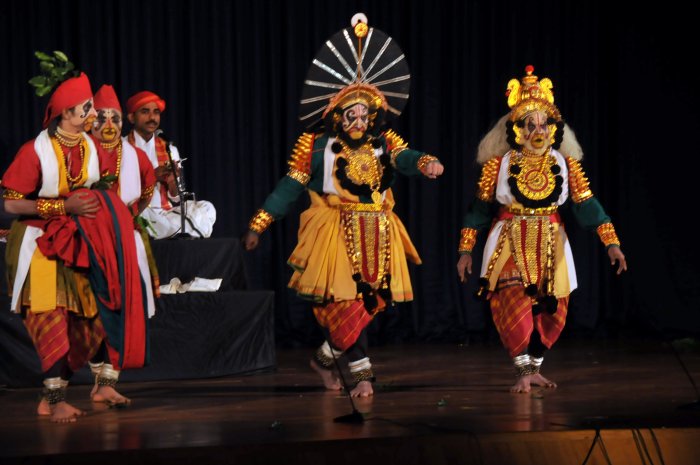 Keremane Shivananda Hegde Group from coastal Karnataka presented Vali Moksha, Yakshagana in its full glory, with colorful aharya, and members of the troupe rendering vachikabhinaya, to the typical Yakshagana music. Shivananda Hegde, the present director of the troupe, follows his late father Keremane Shambhu Hegde, directing and choreographing Yakshagana prasangas in traditional manner. After the initial singing by Bhagavatar Ananth Hegde to the chenda by Krishna Yaji and maddala by Narasimha Hegde, building up the mood of the Yakshagana, the vaddaloga, introduction of the characters Rama and Lakshmana took place. They performed with their bhumi bhramari, circling on the knees, a special movement of Yakshagana. Their head gears and colorful costumes were impressive and lent an excitement for the drama to unfold. The episode starts with abduction of Sita by Ravana. Sita enters crying aloud 'Rama, Rama' and Ravana with attahasya makes fun of Sita at her helplessness. The story as presented was woven around the incidents leading to the revelation and death of Vali, the monkey king. The alliance between Rama and Sugreeva becomes a crucial point of the later happenings in the Ramayana. The episode was selected from the Aranya Khandam of the Ramayana composed by Parthi Subba, a 16th century Yakshagana playwright. Vali and Sugreeva were loving brothers. Once they had a fight with Mayavi, a demon of the region, during which Vali was locked into the cave due to misunderstanding created between them. Vali returned and started torturing Sugreeva. He took Sugreeva's wife as captive and forced Sugreeva to leave the kingdom. Rama and Lakshmana, who were in search of Sita, came across the Rishyamooka Mountain where Sugreeva had taken shelter. From the top of the mountain, Sugreeva sees Rama and Lakshmana coming, sends Hanuman to find out who they are. On knowing they are sons of Dasharatha now in search of Sita, Hanuman takes them to Sugreeva, who seeks their assistance as Vali tortures him, and in return promises to help them with his army of monkeys to march towards Lanka. When Vali and Sugreeva fight they look alike. Rama gives a garland to Sugreeva to wear, so he can be differentiated from Vali, but in battle Sugreeva is no match to Vali's strength, and is wounded. Rama shoots arrow from behind the tree and attacks Vali who is deeply wounded. Vali asks Rama about his unjust act. But finally Vali surrenders to Rama and seeks Moksha. Angada, son of Vali, arrives with his kinsmen. Vali hands over the kingdom to Sugreeva and everyone is united as before. Rama gives Moksha to Vali. The direction by Shivananda Hegde is full of dramatic action. There are few sequences when humour is introduced. The duel between Vali and Sugreeva, Rama's shooting arrow from behind et al are enacted with flavour of the region for which Yakshagana is well known. The dancing is dynamic. On seeing the colorful costumes and movements, there is a general impression that it looks like Kathakali. But there are several differences. In Kathakali, actors do not deliver dialogues. And the music is also very different. In Yakshagana, vachikabhinaya by dancers is a part of the dance-drama. Keremane Shivananda Hegde is the leading artiste of the troupe. Under his supervision, Yakshagana dance-drama form has been flourishing. Congratulations to the Music Academy for inviting the troupe from Karnataka. P. Praveen Kumar 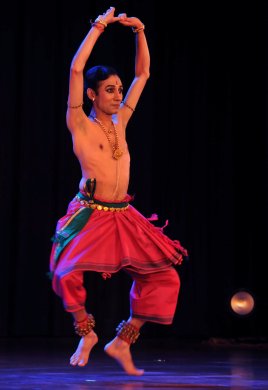 On the penultimate session on 8th January, Bangalore based P. Praveen Kumar performed for the third time in succession at the Academy in the evening slot. After a Keerthane by Suddhananda Bharati set to Durga raga and adi tala in praise of the goddess, he embarked upon Mate Malayadwaja, Daru Varnam in Khamas and adi tala, a composition of Mysore court vidwan Muthiah Bhagavathar. The composition is in praise of Tripurasundari, epitome of Shakti, the confluence of the energies of Lakshmi, Saraswathi, and Parvathy. Praveen's treatment was interesting for displaying the various forms of the goddess. For the word Matangavadana, he etched the iconic image of Ganapati with elephant head and large earlobes, for Kartikeya Guha, showed him arriving on Mayur, his vehicle peacock. As mother Parvati, she feeds both the children, placing the sweet in mouth of Ganapati, whose vehicle is the mouse. The motherly aspect of the goddess was rendered with vatsalya bhava. For alternating nritta passages, Praveen explored a variety of footwork, crisscrossing legs with playfulness and unusual mnemonics. The images of Shankari and Chandrakaladhari were choreographed imaginatively, displaying the gentle aspect of the goddess. The contrast for Chamundeshwari, wearing expressions evoking awe, with wide open eyes and extended arms on sides, he succeeded in bringing out the frightening image of the goddess. In contrast to Manjulvani, the delicate speech, switching off again to bhayanaka form, with bells ringing and releasing attahasya, the demonic laughter, Praveen was at his best. When depicting Shankari, he resorted to peaceful softer mood offering arghya to the goddess. The chanting of the sacred mantras evoked the mood of worship. The epithets of Ruchir geet, Vividha samarasa, Sulabh hridaya, Madhur swara, karuna sagar, like an ocean of compassion, bestowing blessings upon King Krishna Rajendra, Sakalajiva Sarvabhaume, ruling over the universe, seen in Shashimandal as Jaganmata, he unleashed forms in fleeting manner. He often took sitting position while dancing and sprung to action with alacrity. His nritta was sparkling, and teermanams full of punch. The most effective and lasting image was that of ferocious goddess Chamundeshwari, using red light to enhance the effect. The padam Theertha Karainile, a composition of Subramanya Bharatiyar in Ragamalika and adi tala dealt with the feeling of separation, of a nayaka, who on the bank of a river under champak tree was promised by his beloved for a rendezvous, but she did not turn up. He placed his foot in water, waiting for her. The all pervading silence, the gathering of the clouds, when all were asleep, he began to lose all hope of her coming. Praveen expressed the emotional turmoil of the nayak in a succinct manner. His pain of separation became poignant. Devarnama 'Yashode Amma, yethi kula Amma' in Hindustani Kalgada raga and adi tala by Purandaradasa, offered Praveen scope for histrionics. He handled it feelingly, with endearing childhood pranks of Krishna wanting to win sympathy of mother Yashoda, pretending that his feet were aching and would she not have pity upon him and lift him? Krishna complains that he cannot bathe in hot water, nor eat spicy food. Will mother not give him butter and dates which he loves to eat? 'O mother, those people call me a thief and make false complaints. Not only that, those women seeing me on the street come running unto me and pinch my cheeks! Believe me, I am so exhausted that I am unable to walk, my feet are aching, please, lift me up. Amma, if you love me, you will know what a good kid I am!' Praveen extended his arms running towards Yashoda and with naughty smile exited in the wings, winning loud applause. Praveen concluded his performance with Tillana, a composition of Madurai N Krishnan in Simhendramadhyamam raga and adi tala. Nattuvangam by D.V. Prasanna Kumar, vocal by D.S. Srivatsa, mridangam by Lingaraju, flute by Mahesh Swamy and violin by Mandya Nagaraj enhanced the excellence of the dance. Bijayini Satpathy 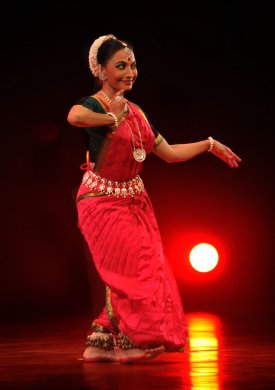 Now a solo artiste, Bijayini Satpathy presented items choreographed by Guru Kelucharan Mohapatra and Surupa Sen. The fare was sumptuous. Bijayini did justice to the dance numbers in keeping with the high standards Nrityagram has established for Odissi. The evergreen Mangalacharan 'Manikya veena mupalayanti' ascribed to poet Kalidasa from Shyamaladandaka is in praise of the goddess Matangi, with veena studded with jewels, she, the languorous one, Madalasa, and with Manjula vagvilas, delicate and melodious speech. The poetic description depicts her with breasts besmeared with kumkum, holding weapons pasha and ankusha, and lo and behold, the image as visualized by Kelubabu takes shape by Bijayini in a striking manner! The music by Pt Bhubaneshwar Misra in Ragamalika and Talamalika has remained a delight to the ears. I saw Surupa Sen's choreography of Srimati after a long time. Bijayini brought alive the image of flowering of a beautiful maiden in her resplendent youth, and one also conscious of her power. Looking into 'Darpana', a looking glass, which etymologically suggests that which increases one's arrogance 'Darpa', more awareness comes as she becomes a woman. And with realization she confides to the Lord: 'All call me beautiful, but what is the meaning of this beauty other than as an offering to you!' It was set to music by Pt Raghunath Panigrahi in Ragamalika and Talamalika. The most endearing abhinaya pada was Suradas's song 'Sun Maiya' - Listen, O mother Yashoda - choreographed by Kelubabu, the music for which was composed by Pt Jasraj set to Ragamalika and ektali. The pada brings in lots of humour. Bijayini demonstrated the meaning of the Braj bhasha song, which helped audience to enjoy the humour when Gopi complains to Yashoda about pranks of Krishna. 'How can I say', complains the Gopi,' what your darling son did? Not only he broke vessels full of milk and butter, but also when I was asleep with my husband, he tied my plait with the moustache of my husband and stealthily ran away. Can you imagine the embarrassment? When I caught him, he kissed me and touched my breasts, see the nail marks. He is not a small one, do not defend him.' Krishna on listening to her complaint, refutes all that as lies, and complains that it was she who made him churn butter, milk cows and punished him. Embracing Krishna, Yashoda dismisses Gopi's accusation saying that her child is so small. 'Look at his delicate fingers and small nails. Your ways of walking seductively, with youth coursing through your body, enticing males, do we all not know? How can my child make such brazen marks on your breasts? Go away and never come again to complain.' Krishna of course smiles naughtily. Bijayini enacted three monologues with finesse evoking hasya for the monologues of Gopi, Krishna and Yashoda. The ashtapadis are de rigueur in an Odissi recital. Choreographed by Surupa Sen, the ashtapadi 'Sakhi he Keshi mathanamudaram' dwells upon the ecstatic experiences and memories of Radha's first encounter with Krishna, when with sweet nothings 'chatu vachanai shatai anukulam' he undid her garment and embraced her, kissing her, 'Sakacha graha chumbana danam.' Radha asks her sakhi to go quickly and bring him to her so that she can unite with him. Surupa's choreography is replete with sensuousness as the ashtapadi demands for the love play between Radha and Krishna. Set to Mishra Pahadi raga and Jatital by Pt Bhubaneswar Mishra, it is one of the popular ashtapadis among dancers. Bijayini performed it with subtle abhinaya and sensuousness. The 'Sita Haran' episode of abduction of Sita from the epic Ramayana set to an excerpt from saint poet Tulasidasa's Rama Charit Manas saw Bijayini enacting various roles with consummate artistry. Choreographed by Kelubabu and set to music by Ashit Desai in Ragamalika and Talamalika, it has several dramatic moments. The heartrending cries of Sita when she is abducted, begging forgiveness of Lakshmana, as she crossed the three lines he had drawn to protect her. The way Kelubabu has choreographed the golden deer's movements, its playing hide and seek, the leaps in the air, capture one's attention. Bijayini's graceful movements received instant applause. The use of Tulasidasa's chaupais has an eternal appeal. Vocal by Jateen Kumar Sahu, mardala by Rohan Dahale, flute by Bhuwan Dhakal, sitar by Aparna Deodhar and lighting by Sujay Saple were highly professional. Priyadarsini Govind  On the last evening of the festival, the audience was eagerly looking forward to watching the performance of senior exponent Priyadarsini Govind. After the Sanskrit shlokas from Abhinaya Darpana, Rangadhideva Jaya Jaya, she had selected Khamas Varnam as a major item for her Margam presentation. It so happened that this year there was a preponderance of Khamas varnams. Priyadarsini chose Mathe Malayadhwaja of Harikesanallur Muthiah Bhagavatar as central piece. Seasoned dancer as she is, her exposition was in keeping with her demeanor, personality and mastery over the idiom. The images of the goddess came alive with the epithets of Shankari, Chamundeshwari, Chandrakaladhari in sharp focus. Chamundeshwari displaying the ferocity, but still in repetition Priyadarsini imbued it with subtlety, the feminine grace being predominant. With her svelte tall, figure with long arms, she created aesthetic patterns in alternating nritta sequences, with exacting teermanams. Varnam ended with devotee receiving blessings of the goddess on a peaceful note. In the two Sanskrit verses on humour, one showing Ganapati and Kartikeya quarreling and Parvati reconciling them, Priyadarsini brought out each one's distinct nature, whereas in another piece Shiva taking to halahala, getting fed up on account of quarrels in the family, was replete with situation which caused humour. Serpent attacking mouse vahanam of Ganapati, lion mount of Parvati attacking Ganapati with elephant face, peacock vahan of Kartikeya attacking serpent, the moon frightened at the fire in hand of the Lord, Parvati displeased and jealous of Ganga in Shiva's jata, all drove Shiva to take halahala! The episode was enacted with enough punch, and with the exit of Shiva with hasta near throat, Priyadarsini revealed his state of getting 'fed up'. Known as a torch bearer of Kalanidhi Narayanan's padam repertoire, Priyadarsini did justice to the padam depicting samanya nayika, who on seeing her truant lover bestowing favours on another woman, unleashes her anger with enough sarcasm when he approaches her and tries to cajole her. Moving her index finger and asking him to leave her, as 'enough is enough', Priyadarsini walked away into the wings holding her head high dismissing the guilty paramour. The finale Tillana in Desh raga by Lalgudi G Jayaraman interspersed with verses of Tirupugazh for which notations were provided by Bombay Jayashree, saw Priyadarsini in fine fettle. She performed the verses with devotional feelings along with exquisite Tillana format. Her accompanists consisted of Lokesh Raj for nattuvangam, Preethy Mahesh for vocal, Shakthivel Muruganandham for mridangam and N.Sigamani for violin.They gave her their customary best support. 'Shrimant Yogi' by Vaibhav Arekar and Sankhya Dance Company 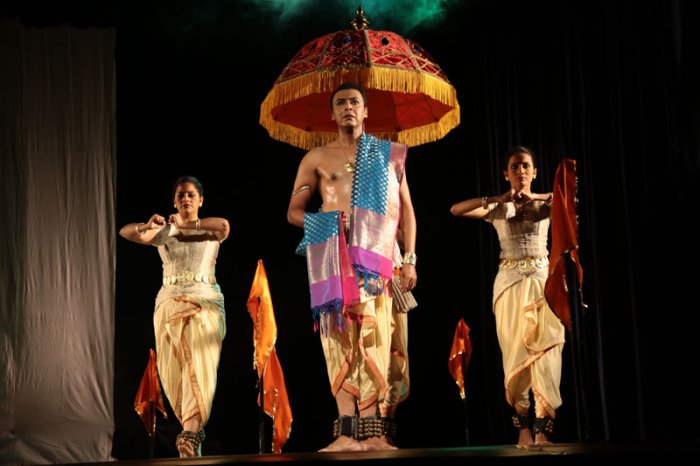 The grand finale of the dance festival was Shrimant Yogi based on historical figure of Chhatrapati Shivaji Maharaj, choreographed by Vaibhav Arekar and performed by him in title role along with his group. It attempted to capture a few impressions of a phenomenon that was Shivaji Maharaj. Vaibhav wove in Bharatanatyam technique, cultural, social and emotional state of the society and of Shivaji himself. With commentary in English to connect the episodes, he succeeded in portraying Shivaji as a Karma Yogi, a fighter, well versed in art of war, including guerilla attacks by his soldiers on Mughals. The narrative used several traditions of singing of Maharashtra like Pavadas, singing about the various victories by Shivaji and his troops, flashback on how he grew up, mother Jeejabai singing lullaby, teaching him to play with swords, and be a freedom fighter for motherland. The lullaby in particular was one in Gujarati which fitted well with the narrative. The tunes of the song and the words 'Mata Jeejabai jhulave, Shivaji ne nindar aave' - mother Jeejabai pushes the cradle and Shivaji is sleeping. Vaibhav has, with choreographic gifts, shown Shivaji growing up, when mother is singing, with excellent images. The commentary mentions that even today if you place your ears to the ground, the sound of horses, running with warriors could be heard. And what an indelible image it was of dancers sitting in a circle, only their palms lit up, striking the floor, creating the sounds in various patterns of talas evoking armies marching! The chorus giving call with 'Hara Hara Mahadev' and soldiers crossing in speed across the stage, leaping up in the air, waving the flags with saffron colour, loudly praising Jay Bhavani, using technique of kalaripayattu artistically and creating an ambience of war were highlights of the production. Shivaji escaping Adil Shah's attack, Bajiprabhu leading the army, being shot from back, but till the sound of the gun suggesting Shivaji's safe reaching Vishalgarh, keeping the enemy away, were scenes that one watched holding one's breath! When Shivaji was crowned, the simple prop of a royal umbrella and a colourful scarf on his bare body displayed the regal demeanour of Shivaji. His encounter with Swami Ramdas Samarth, awakening of the inner spiritual journey, maintaining the rajya dharma, imbued with Gita's upadesh which Krishna gave to Arjuna, 'Karmanyeva adhikarste, maa faleshu kadachana' , the portrayal of Shivaji as Karma Yogi was an excellent development. The contemporary resonances for Independence rang through the unfolding of the dance-drama. Vaibhav Arekar's Sankhya Dance Company's well trained dancers excelled in Bharatanatyam technique. Sushanta Jadhav, their light and costumes designer assisting in choreography, lit the production with exquisite lighting. Another feather in the cap of Vaibhav Arekar. The 14th edition of The Music Academy Dance Festival ended with great jubilation. The bonhomie that develops during the festival is a healthy sign. The exchange between participating dancers of young generation is welcome. Also the broadmindedness and appreciation of dancers witnessed during the festival is another welcome sign. The regulars are bound to have several suggestions. They were aired during the festival. One hopes since there is scope for improvement in all such festivals, some of the positive suggestions may be implemented.  Dr. Sunil Kothari is a dance historian, scholar, author and critic, Padma Shri awardee and fellow, Sangeet Natak Akademi. Dance Critics' Association, New York, has honoured him with Lifetime Achievement award. Post your comments Please provide your name and email id when you use the Anonymous profile in the blog to post a comment. All appropriate comments posted with name and email id in the blog will also be featured in the site. |